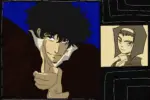Sister Rosetta Tharpe is the Godmother of Rock ‘n’ Roll. Her biographer, Gayle Wald, has sung the singer’s praises over the years: “When you see Elvis Presley singing early in his career … imagine he is channeling Sister Rosetta Tharpe. It’s not an image I think we’re used to thinking about when we think of rock ‘n’ roll history — we don’t think about the black woman behind the young white man.” Though she is not given the recognition she rightly deserves, the impact of Tharpe’s incredible existence is laced in the music of rock ‘n’ roll for the rest of time.
Tharpe, or Rosetta Nubin, was born in 1915 in Cotton Plant, Arkansas. She grew up with her parents, Katie Bell Nubin and Willis Atkins, who greatly encouraged her musical talents. As a child, she attended the Church of God in Christ, where her mother was a preacher. At a young age, Nubin already displayed extraordinary musical abilities; her small community hailed her as a prodigy.
She started playing the guitar during church services at 4 years old and was a performer alongside her mother in a traveling evangelical group. Her touring throughout the South would influence her music in the future. As an artist, Tharpe integrated sounds from rural towns she would frequent while touring with the evangelical group. The mother-daughter musical duo played at gospel concerts nationwide until settling in Chicago in the mid-1920s.
Nubin had a brief marriage to Thomas Tharpe in 1938, a preacher whose surname she would continue to use on stage.
Just like her travels as a child, her time in Chicago would also influence her. There, she encountered the rhythmic beats of blues and jazz. Tharpe’s time in the Windy City saw her blossom as a musician. She signed on with Decca Records at 23 years old and began recording her first few pieces of music with the Lucky Millinder’s Jazz Orchestra. Some of these tracks included the gospel-rock track, Thomas Dorsey’s “Rock Me,” and “The Lonesome Road.” “Rock Me” established the budding musician as an overnight gospel artist sensation. As her career took off, she developed her own unique sound, mixing traditional gospel lyrics with up-tempo jazz and blues.
https://www.youtube.com/watch?v=PO4MNE31edM&feature=emb_title
Rolling Stone’s Will Hermes described Tharpe’s “Rock Me” as a “transformed spiritual … recorded with her soaring held notes and sexy growls back in 1938 — when the latter-day King of Rock ‘n’ Roll, Elvis Presley, was still a toddler.”
In 1944, Tharpe released what some believe to be the first rock ‘n’ roll song, “Strange Things Happening Every Day.” It was an incredible showcase of her guitar skills and vocals and the first gospel track to chart on Billboard’s Harlem Hit Parade.
Tharpe gained even more exposure when she played at Harlem’s Cotton Club with Cab Calloway and at Carnegie Hall in the Spirituals to Swing concert. Her style of music catapulted her to stardom, but it also brought controversy.
Firstly, a woman playing guitar in nightclubs was scandalous at the time.
Second, Tharpe’s effortless marriage of gospel lyrics with jazz and blues in her shows was not accepted by orthodox audiences; during World War II, however, Tharpe’s notoriety allowed her to be one of the two gospel artists to record V-disks and perform for U.S. soldiers overseas. Afterward, she embarked on another nationwide tour with the Dixie Hummingbirds.
Sister Rosetta Tharpe also had relationships with both men and women and was married several times. In the 1940s, she met her partner, Marie Knight. Tharpe first met her at a concert in New York City. Marie Knight was performing with Mahalia Jackson; it was at this concert that she entranced Tharpe. After her performance, she tracked down the singer and the two became lovers and bandmates. Sister Rosetta Tharpe sang and played the guitar, while Knight performed on the piano and sang. Their performances were a beautiful combination of Knight’s contralto vocals and Tharpe’s vivacious stage presence.
The duo recorded and released the track “Up Above My Head.” Their song was a hit with their audiences, and they performed together for several years afterward. The duo attracted large crowds as they traveled the church circuit, releasing more tracks together throughout their partnership.
Of their relationship, Wald wrote in 2007 that “For homosexuals in her audiences, rumors about Rosetta’s sexuality might have been liberating, an invitation to look for tell-tale signs of affirmation of their own veiled existence.”
Entering the 1950s, Tharpe’s popularity began to fade and she ended her partnership with Knight. An increased interest in blues music in Europe allowed Tharpe to tour the continent in 1964. However, at the same time, her devotion to gospel music and the ascendance of white rock musicians into mainstream culture dwindled her popularity.
Tharpe had to cancel a European tour with Muddy Waters in 1970 due to poor health. Still, she persisted and continued performing. When she suffered a stroke, Tharpe returned to stay with her mother in Philadelphia. Due to further complications from diabetes, her leg had to be amputated. Right before a recording session in October 1973, Sister Rosetta Tharpe had a second stroke. She passed away a few days later at 58 years old. The singer had a small funeral, where Knight did Tharpe’s makeup and chose the clothes she would be buried in.
Sister Rosetta Tharpe is one of the most influential figures in musical history, especially rock ‘n’ roll. Her guitar playing inspired other legends like Bob Dylan and Elvis Presley, and she helped pave the path for future singers like Miranda Lambert. The Rock & Roll Hall of Fame inducted her in 2018.
Her tombstone reads, “She would sing until you cried, and then she would sing until you danced for joy. She kept the church alive and the saints rejoicing.” While Tharpe’s name might not be the first to come to mind when thinking about rock ‘n’ roll legends, her impact perseveres.

















